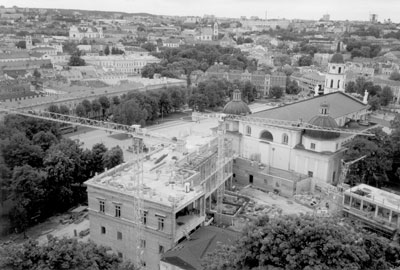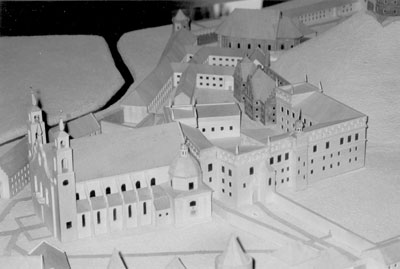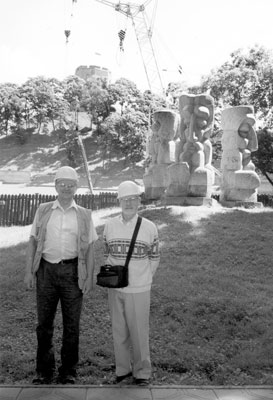Rebirth of a palace in Vilnius, Lithuania
by Julie Skurdenis
I travel to Lithuania often, most recently in June 2005. Every time I visit Vilnius, its capital, the first place I head for is the square next to the Cathedral just at the edge of the Old Town. It’s here that I watch an archaeological miracle taking place: the rebirth of a palace destroyed over 200 years ago.
It’s something I could never have imagined when I first visited Lithuania in 1977 when it was still under the domination of the USSR. At that time the Cathedral had been turned into an art gallery and there was no thought of the palace that once existed there beside the Cathedral.
A bit of history
In the 15th century, during the long reign (1392 to 1430) of Grand Duke Vytautas, Lithuania became one of the largest and most powerful countries in Europe, its territory stretching from the Baltic to the Black Sea and encompassing portions of what is now Poland, Russia, Belarus and Ukraine. Vilnius, founded in 1323 by an earlier grand duke, Gediminas, was its capital.
On a prominent hill, now called Gedimino Hill, at whose base the Neris and Vilnia rivers meet, stood an Upper Castle with fortifications, towers and a castle hall crowded close together. This Upper Castle complex was meant as a place of final refuge in times of siege.
At the base of the hill stood an extensive Lower Castle that expanded over the centuries to include churches, towers, defensive walls, arsenals and a palace. This palace at the heart of the Lower Castle complex served as the administrative and cultural center of Lithuania’s empire.
The earliest, 14th-century Royal Palace may have been wooden, but it was succeeded in the early 15th century — during the reign of Grand Duke Vytautas — by a gothic-style palace consisting of three wings, each two stories high. By the beginning of the 16th century the palace took on a Renaissance appearance and consisted of four buildings, each three stories high, enclosing a roughly quadrangular courtyard.
The Royal Palace stood for over 300 years until sacked and burned by invading Russians in 1655. It was never again used as a palace. What remained was razed in 1801 by Czarist troops.
In 1987, toward the end of the Soviet occupation, archaeological research began, snowballing after Lithuania regained its independence in 1991. Lithu-ania’s history began to emerge from the ground — 13th-century fortifications from the time of Mindaugas, Lithuania’s only ruler to bear the title of king (subsequent rulers were called grand dukes), 14th-century foundations from the earliest palace, and thousands of artifacts from all eras, 300,000 at last count.
Palace reborn
In 2000, the Lithuanian Parliament passed a law mandating that the Royal Palace that once existed be rebuilt by 2009 in time for the celebration of Lithuania’s millennium. Groundbreaking took place in May 2002. So began the rebirth of the Royal Palace of the Lithuanian grand dukes. Archaeological excavations were to be succeeded by architectural reconstruction.
With four years to go to the celebration of the country’s millennium, the reconstruction is well under way. Fortunately, there were 18th- and 19th-century illustrations to show what the exterior of the palace once looked like. These have served as architectural blueprints for the palace’s resurrection.
Of the hundreds of thousands of artifacts found on-site during the excavations, approximately a thousand are currently on display in the nearby Applied Arts Museum, itself a 16th-century structure built over even earlier Lower Castle defensive walls. Entitled “Artifacts from the Royal Palace of the Grand Duchy of Lithuania,” the exhibit includes samplings from all periods of the palace’s history.
As one would expect, there are keys, jewelry, pottery fragments and coins; one of the oldest coins dates from 1392. More unusual finds include a 14th-century wooden comb, 15th-century molds for casting rings, remnants of a 16th-century felt hat, and a 17th-century leather shoe that once belonged to a child. There’s also an interesting-looking 3-legged frying pan of indeterminate age, and chamber pots that are 500 years old. There’s even a breast plate that was somehow left behind 400 years ago, left for archaeologists to discover.
Ceramic tiles abound. They once covered palace roofs, floors and the huge stoves that helped heat cavernous high-ceilinged rooms. These tiles, too, span the ages — a 15th-century brown tile with two beasts sticking their tongues out at each other, a 16th-century brownish-red tile depicting a splay-tailed mermaid, and a 17th-century green tile showing a woman admiring herself in a mirror, evidently part of an allegorical series on the five senses (this tile depicted the sense of sight).
One of the oldest items displayed in the exhibit is a 13th-century brick depicting a griffin; this may have come from the earliest castle on the site. The item I like best is the olive-colored, diamond-shaped brick dating from the 14th century that shows a fish swallowing a man, probably a depiction of the Biblical Jonah and the whale.
Central to the exhibit are the models showing what both the Upper and Lower Castle complexes looked like at various times in their histories: pre-Gothic, Gothic, Renaissance and Baroque.
The exhibit is scheduled to run until Dec. 31, 2007. The Applied Arts Museum is located at 3A Arsenalo, about a 5-minute walk from the Cathedral. Its hours are 11-6 Tuesday to Saturday and 11-4 Sunday; it’s closed Monday. There is an admission charge of eight Lithuanian litas, about $3 at the time of our visit.
If you go. . .
Since Ive been to Lithuania so often, I made most of our trip arrangements myself: flights, hotel reservations, excursions outside Vilnius, etc. I flew Finnair (800/950-5000) from New York to Helsinki and then on to Vilnius. Finnair has been my airline of choice for most of my trips to Lithuania and the other Baltic countries because of their schedules, comfort and safety record.
In Vilnius, we stayed at the Shakespeare Hotel (Bernardinu Str. 8/8, LT-01124, Vilnius, Lithuania; phone 370-5-2665885, fax 370-5-2665886, e-mail info@shakespeare.lt or visit www.shakespeare.lt) in the Old Town, a 5-minute walk from the Royal Palace.
The Shakespeare is a small boutique hotel with rooms named after authors. Each room is unique and beautifully decorated and includes books by the author after whom it is named. So far, over several visits to the Shakespeare Hotel, I’ve stayed in the Hemingway, Twain, Trollope and, of course, Shakespeare rooms.
Many of the rooms have views of the Cathedral, the Upper Castle or one of the churches for which Vilnius is famous. For a double room, prices range from $215 to $272. Be sure to ask if there are any specials.
For those considering a first-time trip to either Lithuania or the other Baltic countries, Latvia or Estonia, I can recommend Vytis Tours in Douglaston, New York (phone 800/778-9847 or 718/423-6161, e-mail vyttours@earthlink.net or visit www.vytistours.com).
Another company to consider is Lithuanian Tours, based in Vilnius (phone 370-5-2724154, fax 370-5-2721815, e-mail contact@lithuaniantours.com or visit www.lithuaniantours.com).
In the past, I’ve used Vytis Tours for everything from flight arrangements to car reservations. On this most recent trip to Lithuania, in June 2005, I used Lithuanian Tours for several hotel reservations outside Vilnius and for arranging a 3-night excursion to Minsk, capital of Lithuania’s neighbor, Belarus.
If you’d like to visit the construction site of the Royal Palace as I did, arrangements can be made at the booth set up right in front of its almost-completed south facade, next to the Cathedral. There is no charge, but donations toward the rebuilding are welcomed.
—Focus on Archaeology is written



